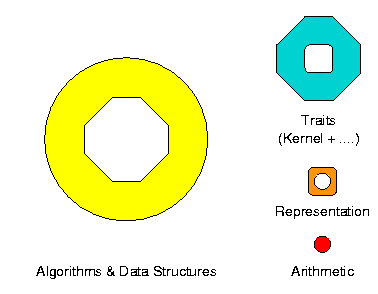CGAL代码阅读跳坑指南
整体框架介绍

CGAL中的算法和数据结构由它们使用的对象类型和操作参数化。它们可以处理满足特定语法和语义需求的任何具体模板参数。为了避免长参数列表,参数类型被收集到一个单独的类中,称为CGAL中的traits类。Concept是由一组需求定义的类型的抽象。概念是由一组需求定义的类型的抽象。如果任何具体类型满足与概念相对应的一组需求,则称为这个概念对应的Model。使用这个术语,我们可以说CGAL算法或数据结构带有一个traits概念,并且可以与这个概念的任何具体traits模型一起使用。
CGAL定义了geometry kernel的概念。理想情况下,这个概念的任何模型都可以与任何CGAL算法一起使用。当然,只有当一个算法或数据结构对其traits类的需求被核心概念所包含时,也就是说,如果一个算法或数据结构没有核心概念定义中未涵盖的特殊需求,这种情况才成立。目前,CGAL提供了一个基本geometry kernel的概念,它定义了各种几何对象,如点、线段、直线、圆和对它们的操作,以及另外两个概念,circular kernel和spherical kernel。最后两个内核的目标是在平面上的圆和圆弧上指定一大组功能(circular kernel),并为生活在三维球体上的圆、圆弧(spherical kernel)指定类似的功能。
CGAL目前为CGAL 2D和3D内核概念提供了几个模型,为2D圆形和3D球形内核概念提供了一个模型。。它们再次被参数化,并且在几何对象的表示和所涉及类型的可交换性方面有所不同。在前四种情况下,内核由数字类型参数化,数字类型用于存储坐标,决定内核原语的基本算法。
在最后两种情况下,圆核和球核也由Algebraic Kernel参数化,这与代数基础一起,是CGAL中第三个明显的高阶泛化。CGAL中的代数基础是表示代数结构的一组概念,由传统代数中著名的对应概念驱动。代数基础决定每个代数结构的运算、它们的属性(例如,它们是精确的还是近似的)以及它们之间的互操作性。Algebraic Kernel负责为CGAL算法中使用的geometry kernel或特征类所需的代数操作提供抽象。目标是能够构造、比较和执行多项式方程的实根运算。根据用于确定根的多项式的变量数量,有不同的概念(目前有单变量和双变量代数核的概念),以及针对库的特定几何高层(如圆形和球形核)的专门概念。这些概念每个概念至少有一个模型。
CGAL中还有更多的互补层。最基本的层是配置层。此层负责根据安装期间运行的测试的结果设置配置标志。支持库层在支持库手册中有文档记录,其中包含处理CGAL中的可视化、数字类型、流和STL扩展等内容的包。
以上内容是对官方文档中介绍的翻译,见:https://doc.cgal.org/latest/Manual/devman_intro.html#secoverall_design
个人理解
Traits、Concept:都是用来定义一组满足特定语法和语义需求的概念(参数类型的集合);
Model:是对于这些参数类型的实现,对Kernel进行一定的封装;
Kernel:是最终概念具体实现的地方;
Algorithm:指的是利用概念提供的信息,完成对应的实现;
示例分析
下面以https://doc.cgal.org/latest/Convex_hull_2/classCGAL_1_1Convex__hull__traits__2.html为例验证上面的理解是不是有问题的,下面不考虑算法到底是怎么实现的。
Concepts
https://doc.cgal.org/latest/Convex_hull_2/classConvexHullTraits__2.html
定义中说明了convex hull and extreme point算法被参数化为Traits类,定义了算法需要的对象和判断的方法。其中类型主要包括:Point_2, Equal_2, Less_xy_2, Less_yx_2, Left_turn_2, Less_signed_distance_to_line_2, Less_rotate_ccw_2, Orientation_2;需要的方法有:拷贝构造函数,Equal_2 equal_2_object(), Less_xy_2 less_xy_2_object(), Less_yx_2 less_yx_2_object(), Less_signed_distance_to_line_2 less_signed_distance_to_line_2_object (), Less_rotate_ccw_2 less_rotate_ccw_2_object(), Left_turn_2 left_turn_2_object(), Orientation_2 orientation_2_object()。
Model
CGAL::Convex_hull_constructive_traits_2
CGAL::Convex_hull_traits_2<R>
CGAL::Convex_hull_traits_adapter_2<R>
CGAL::Projection_traits_xy_3<K>
CGAL::Projection_traits_yz_3 <K>
CGAL::Projection_traits_xz_3<K>
代码示例(仅使用kernel)
#include <CGAL/Exact_predicates_inexact_constructions_kernel.h>
#include <CGAL/ch_graham_andrew.h>
typedef CGAL::Exact_predicates_inexact_constructions_kernel K;
typedef K::Point_2 Point_2;
int main()
{
CGAL::set_ascii_mode(std::cin);
CGAL::set_ascii_mode(std::cout);
std::istream_iterator< Point_2 > in_start( std::cin );
std::istream_iterator< Point_2 > in_end;
std::ostream_iterator< Point_2 > out( std::cout, "
" );
CGAL::ch_graham_andrew( in_start, in_end, out );
return 0;
}
ch_graham_andrew提供了两个接口,如下:
// With out traits
template <class InputIterator, class OutputIterator>
inline
OutputIterator
ch_graham_andrew( InputIterator first,
InputIterator last,
OutputIterator result );
// With traits
template <class InputIterator, class OutputIterator, class Traits>
OutputIterator
ch_graham_andrew( InputIterator first,
InputIterator last,
OutputIterator result,
const Traits& ch_traits );
那么就需要详细看下Kernel的实现,此处直看偏特化为true的情况:
class Epick
: public Filtered_kernel_adaptor<
Type_equality_wrapper< Simple_cartesian<double>::Base<Epick>::Type, Epick >, true >
{};
typedef Epick Exact_predicates_inexact_constructions_kernel;
首先看一下最内层Simple_cartesian<double>::Base<Epick>::Type对应的是:Cartesian_base_no_ref_count<double,Epick>,于是得到
class Epick
: public Filtered_kernel_adaptor<
Type_equality_wrapper< Cartesian_base_no_ref_count<double,Epick>, Epick >, true >
{};
Epick最后的基类是:Cartesian_base,该基类定义了Point_2, Vector_2等数据结构,如下 :
typedef PointC2<Kernel> Point_2;
typedef VectorC2<Kernel> Vector_2;
typedef DirectionC2<Kernel> Direction_2;
/// ...
PointC2,Vector2,DirectionC2等是可以找到具体实现的。其他的概念中对应的类型和函数的实现见:
template < typename FT_, typename Kernel_ >
struct Cartesian_base_no_ref_count
: public Cartesian_base< Kernel_, FT_ >
{
typedef FT_ RT;
typedef FT_ FT;
// The mechanism that allows to specify reference-counting or not.
template < typename T >
struct Handle { typedef T type; };
template < typename Kernel2 >
struct Base { typedef Cartesian_base_no_ref_count<FT_, Kernel2> Type; };
typedef Kernel_ K;
#define CGAL_Kernel_pred(Y,Z) typedef CartesianKernelFunctors::Y<K> Y;
Y Z() const { return Y(); }
#define CGAL_Kernel_cons(Y,Z) CGAL_Kernel_pred(Y,Z)
#include <CGAL/Kernel/interface_macros.h>
};
#include <CGAL/Kernel/interface_macros.h> 定义了概念中对应的函数,类型,具体如下:
CGAL_Kernel_pred(Less_signed_distance_to_line_2,
less_signed_distance_to_line_2_object)
CGAL_Kernel_pred(Equal_2,
equal_2_object)
CGAL_Kernel_pred(Less_xy_2,
less_xy_2_object)
CGAL_Kernel_pred(Less_yx_2,
less_yx_2_object)
CGAL_Kernel_pred(Less_signed_distance_to_line_2,
less_signed_distance_to_line_2_object)
CGAL_Kernel_pred(Less_rotate_ccw_2,
less_rotate_ccw_2_object)
CGAL_Kernel_pred(Left_turn_2,
left_turn_2_object)
CGAL_Kernel_pred_RT(Orientation_2,
orientation_2_object)
// ...
上面的定义都可以通过下面的宏进行展开:
#define CGAL_Kernel_pred(Y,Z) typedef CartesianKernelFunctors::Y<K> Y;
Y Z() const { return Y(); }
CartesianKernelFunctors中定义了各种概念上具体的Functor类型,这些Functor提供了一些辅助的几何关系计算的功能,同时这些类型的实现是由Cartesian_base中对应的类型组装而成的。
template <class InputIterator, class OutputIterator>
inline
OutputIterator
ch_graham_andrew( InputIterator first,
InputIterator last,
OutputIterator result )
{
typedef std::iterator_traits<InputIterator> ITraits;
typedef typename ITraits::value_type value_type; // Kernel::Point_2
typedef CGAL::Kernel_traits<value_type> KTraits; //
typedef typename KTraits::Kernel Kernel; // Kernel
return ch_graham_andrew( first, last, result, Kernel());
}
算法内部中利用了kernel中依据概念提供的数据结构和辅助函数。
代码示例(使用Traits)
对应的示例代码如下:
#include <CGAL/Exact_predicates_inexact_constructions_kernel.h>
#include <CGAL/convex_hull_2.h>
#include <CGAL/Convex_hull_traits_adapter_2.h>
#include <CGAL/property_map.h>
#include <vector>
#include <numeric>
typedef CGAL::Exact_predicates_inexact_constructions_kernel K;
typedef K::Point_2 Point_2;
typedef CGAL::Convex_hull_traits_adapter_2<K,
CGAL::Pointer_property_map<Point_2>::type > Convex_hull_traits_2;
int main()
{
std::vector<Point_2> points = { Point_2(10,0),
Point_2(3,4),
Point_2(0,0),
Point_2(10,10),
Point_2(2,6) };
std::vector<std::size_t> indices(points.size()), out;
std::iota(indices.begin(), indices.end(),0);
CGAL::convex_hull_2(indices.begin(), indices.end(), std::back_inserter(out),
Convex_hull_traits_2(CGAL::make_property_map(points)));
for( std::size_t i : out){
std::cout << "points[" << i << "] = " << points[i] << std::endl;
}
return 0;
}
先来认识下:CGAL::make_property_map:
template <class T>
struct Pointer_property_map{
typedef boost::iterator_property_map< T*,
boost::typed_identity_property_map<std::size_t>,
T,
T&> type; ///< mutable `LvaluePropertyMap`
typedef boost::iterator_property_map< const T*,
boost::typed_identity_property_map<std::size_t>,
T,
const T&> const_type; ///< non-mutable `LvaluePropertyMap`
};
template <class T>
inline
typename Pointer_property_map<T>::type
make_property_map(T* pointer)
{
return typename Pointer_property_map<T>::type(pointer);
}
可见最终会导向:boost::iterator_property_map。简单来讲就是用来将随机访问的迭代器转换成LvaluePropertyMap,该类型提供了operator[],和get()函数来访问对象。进一步了解可以查找:Boost Property Map Library。
接着看一下:Convex_hull_traits_2(CGAL::make_property_map(points))就是构建了一个traits类。这个traits内部直接实现了concepts中给出的需求,如下:
template<class Base_traits,class PointPropertyMap>
class Convex_hull_traits_adapter_2:public Base_traits{
typedef typename boost::property_traits<PointPropertyMap>::key_type Point_2;
struct Less_xy_2 : public Base_traits::Less_xy_2{
Less_xy_2(const PointPropertyMap& ppmap,const typename Base_traits::Less_xy_2& base):
Base_traits::Less_xy_2(base),ppmap_(ppmap){}
const PointPropertyMap& ppmap_;
bool operator()(Arg_type p,Arg_type q) const {
return static_cast<const typename Base_traits::Less_xy_2*>(this)->operator()(get(ppmap_,p),get(ppmap_,q));
}
};
struct Equal_2 : public Base_traits::Equal_2{ ... }
//...
Equal_2 equal_2_object () const {return Equal_2(ppmap_,static_cast<const Gt*>(this)->equal_2_object() );}
Left_turn_2 left_turn_2_object () const {return Left_turn_2(ppmap_,static_cast<const Gt*>(this)->left_turn_2_object() );}
//...
这里的Base_traits就是对应上面示例中的的Kernel。以Less_xy_2为例,operator()最后调用的是:
static_cast<const typename Base_traits::Less_xy_2*>(this)->operator()(get(ppmap_,p),get(ppmap_,q));
这里就有完美的切换到了Kernel的实现中到了。
But,为什么么要这么设计,这么实现呢?这个我就不懂了。。,希望大家一起探索下。。
小结
针对相关代码的阅读,可以先理解concept中对应的数据类型和函数。然后再看对应的算法实现。看算法实现的时候,就不用过多关注kernel中和concept相关的内容了,更多的关注算法实现的过程即可。不然代码跳来跳去很快就会晕晕乎乎了。